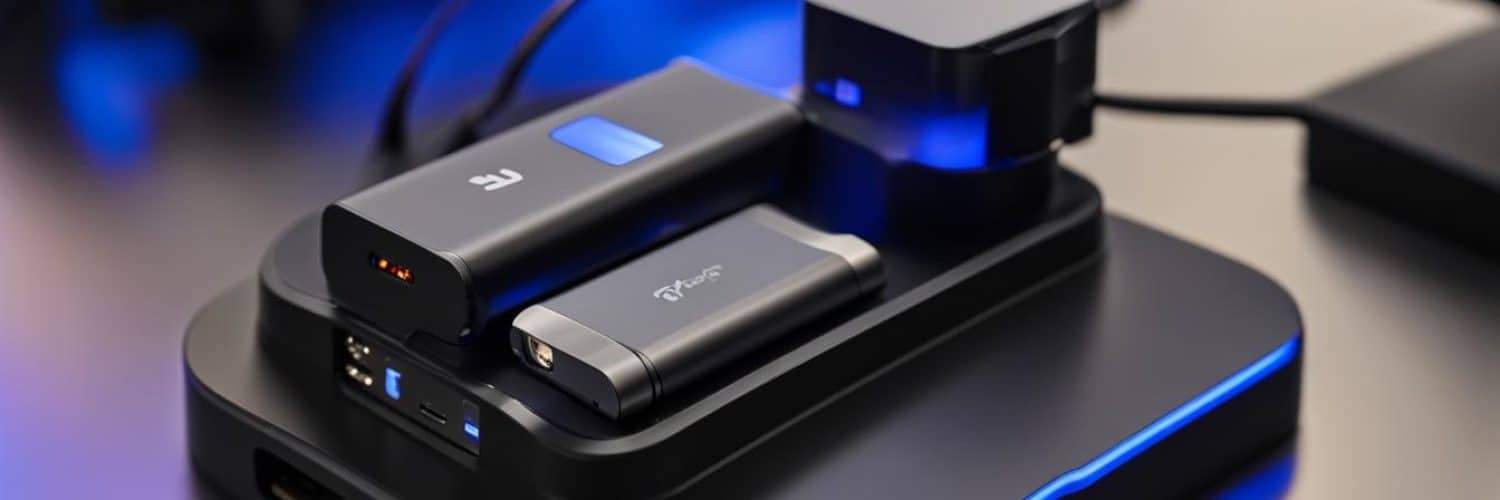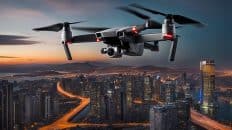Welcome to our guide on DJI batteries! As an essential component of DJI drones, the battery plays a crucial role in providing power for flight and ensuring longer flight times. In this article, we will share valuable care tips, charging information, and solutions to common concerns related to DJI batteries.
Whether you’re a drone enthusiast or a professional pilot, understanding how to care for and maintain your DJI battery is essential for optimal performance and longevity. From maximizing battery life to troubleshooting charging issues, we’ve got you covered.
Key Takeaways:
- Follow care and maintenance practices to maximize your DJI battery’s lifespan.
- Use a DJI-approved charger and follow manufacturer guidelines for charging.
- Be aware of signs of battery swelling and take appropriate action.
- Understand flight times and factors that can affect battery performance.
- Ensure you have compatible batteries for your specific DJI drone model.
Maximizing DJI Battery Life: Care and Maintenance Tips
To ensure the longevity of your DJI battery and optimize its performance, it is essential to follow proper care and maintenance practices. By implementing these tips, you can extend the battery life and enhance your overall flying experience.
- Store at Recommended Temperature Range: Storing your DJI battery within the recommended temperature range is crucial for its health and longevity. Extreme temperatures, both cold and hot, can significantly impact the battery’s performance and lifespan. Aim to store the battery in a dry place at a temperature between 20 to 25 degrees Celsius.
- Avoid Extreme Temperatures: Extreme temperatures can have adverse effects on the battery’s capacity and overall performance. Avoid exposing the battery to direct sunlight, particularly during hot weather. Similarly, extreme cold can affect the battery’s ability to hold a charge. It’s recommended to allow the battery to acclimate to room temperature before charging or using it.
- Avoid Overcharging or Overdischarging: Overcharging or overdischarging the DJI battery can impact its lifespan and capacity. Ensure you follow the manufacturer’s recommended charge cycles, typically stated in the manual or on the DJI website. Avoid leaving the battery connected to the charger for an extended period after it has reached a full charge. Additionally, avoid using the battery until it is fully depleted, as this can strain the cells and reduce its overall lifespan.
- Regularly Check Battery Health: Periodically checking the health of your DJI battery is important to identify any potential issues or degradation. Most DJI drones have a battery health check feature in the accompanying mobile app. Taking advantage of this feature allows you to monitor the battery’s condition and take appropriate actions if necessary.
- Use the Battery Regularly: DJI batteries perform optimally when they are used regularly. If you have multiple DJI batteries, ensure you rotate their usage to prevent one battery from being heavily utilized while the others remain idle for extended periods.
By implementing these care and maintenance practices, you can maximize the lifespan of your DJI battery and ensure it continues to provide reliable power for your drone adventures.
Fly with Peace of Mind: A Quote from DJI
“Taking care of your drone’s battery is crucial in ensuring that it serves you well throughout its lifespan. DJI batteries are designed with safety and performance in mind, and following the recommended care and maintenance practices will help you make the most out of your flying experience.”
– DJI Support Team
| Benefits of Proper Care and Maintenance | Consequences of Neglecting Care |
|---|---|
|
|
DJI Battery Charging: Best Practices and Tips
Properly charging your DJI battery is crucial for ensuring its longevity and optimal performance. Follow these best practices and tips to keep your battery in top condition.
- Use a DJI-Approved Charger: It is important to use a charger specifically designed for DJI batteries. DJI-approved chargers are built to meet the battery’s charging requirements, ensuring safe and efficient charging.
- Follow Manufacturer’s Guidelines: Always refer to the manufacturer’s guidelines and instructions for charging your DJI battery. These guidelines provide important information on charging times, voltage limits, and other considerations specific to your battery model.
- Proper Battery Insertion: Ensure that the battery is securely inserted into the drone or battery charger. A loose connection can prevent the battery from charging properly.
- Secure Connection: Confirm that the battery is firmly connected to the charger. Loose connections can lead to unreliable charging or intermittent charging issues.
- Avoid Overcharging: Overcharging can damage the battery and reduce its overall lifespan. Once the battery reaches its full charge, disconnect it from the charger to prevent overcharging.
- Charging in the Recommended Temperature Range: Charge the battery within the recommended temperature range provided by DJI. Extreme temperatures can affect the charging process and potentially damage the battery.
If you encounter any issues with charging, such as the battery not charging, try the following troubleshooting steps:
- Check Charger Compatibility: Ensure that the charger you are using is compatible with your DJI battery model. Using an incompatible charger can lead to charging issues.
- Inspect Charging Port: Examine the charging port on both the battery and the charger for any signs of damage or debris. Clean the charging port gently if necessary.
- Restart Charging Process: Disconnect and reconnect the battery to the charger, and try charging it again. Sometimes, a minor connection issue can be resolved with a restart.
- Try a Different Outlet: Plug the charger into a different power outlet to rule out any issues with the electrical supply.
- Check Battery Health in DJI App: Use the DJI app to check the battery’s health and status. It may provide insights into any underlying issues that may be affecting the charging process.
By following these best practices and troubleshooting steps, you can ensure that your DJI battery charges correctly and maintains its performance over time.
Remember:
Proper charging practices and regular maintenance are essential for keeping your DJI battery in optimal condition and maximizing its lifespan.
Now let’s take a look at some important signs that indicate battery swelling and the appropriate actions to take in the next section.
| Signs of Battery Swelling | Actions to Take |
|---|---|
| Battery becomes thicker or bulges | Stop using the battery immediately and do not attempt to charge it. Safely dispose of the battery according to the manufacturer’s guidelines |
| Unusual heat or odor coming from the battery during charging | Stop charging the battery and remove it from the charger. Allow it to cool down in a safe, well-ventilated area. Contact DJI support for further assistance. |
| Increase in battery voltage or abnormal behavior | Discontinue use of the battery and consult DJI support for guidance. Continued use may pose safety risks. |
Signs of Battery Swelling and What to Do
Battery swelling is a common concern among drone users, and it’s important to be aware of the signs and take appropriate action. Swelling often occurs due to overcharging, exposure to extreme temperatures, or physical damage. If you notice any of the following signs, it may indicate that your DJI battery is swelling:
- Increased thickness or bulging
- Warped or distorted shape
- Hissing or hissing sounds
- Unusual heat coming from the battery
If you observe any of these signs, it is crucial to stop using the battery immediately and take the necessary precautions to prevent any potential risks. Swollen batteries have the potential to leak, catch fire, or even explode.
When handling a swollen battery, always wear protective gloves and eyewear for your safety. Make sure to place the battery in a non-flammable container such as a metal container or a glass jar with a lid. This will prevent any potential hazards caused by venting gases or leaking electrolytes.
“A swollen battery should never be ignored or used.”
To address the issue properly, do not attempt to puncture, puncture or crush the swollen battery, or dispose of it in regular household waste. Instead, follow the guidelines provided by DJI for proper disposal in your area. Many regions have specific regulations for the safe disposal of lithium-ion batteries, so it’s crucial to adhere to these guidelines to protect the environment and prevent any potential harm.
DJI understands the importance of battery safety, and they offer battery replacement options for their customers. If you have a swollen battery, contacting DJI support or visiting their official website can provide you with the necessary information on how to proceed.
Remember, safety should always be your top priority when dealing with battery swelling. Taking prompt action when you notice the signs and following the recommended steps for disposal or replacement will help ensure a safe flying experience.
Actions to Take for Swollen DJI Batteries
| Steps | Description |
|---|---|
| Stop using the battery immediately | Prevent any potential risks and avoid further damage. |
| Handle the battery with care | Wear protective gloves and eyewear when dealing with a swollen battery. |
| Place the battery in a non-flammable container | Store the swollen battery in a safe container to prevent leaks or venting gases. |
| Follow proper disposal guidelines | Refer to DJI guidelines or local regulations for the safe disposal of swollen batteries. |
| Consider battery replacement | Contact DJI support or visit their official website for information on battery replacement options. |
By taking the appropriate steps when noticing signs of battery swelling, you can ensure your safety and the safety of those around you. Remember to prioritize battery care and follow proper disposal procedures to minimize any potential risks.
Understanding Flight Times and Battery Performance
The flight time of a DJI drone is influenced by various factors, with the battery’s capacity and the drone’s power requirements playing a significant role. DJI offers batteries with different capacities, and understanding their impact on flight times is crucial when planning your drone activities.
When it comes to flight times, it’s important to note that they may vary based on several factors. Weather conditions, such as wind speed and temperature, can affect the drone’s energy consumption and flight duration. Heavier payloads also require more power, which can reduce flight times. Additionally, the flying style, including speed and maneuvers, can impact the battery’s efficiency.
Optimizing your flight time
To optimize your flight time and make the most of DJI batteries, consider the following tips:
- Maintain your batteries properly by following the care and maintenance instructions provided by DJI.
- Carry spare batteries to extend your flying sessions. Having fully charged backup batteries allows you to quickly swap them out when the current one runs low, minimizing downtime.
- Plan your flights strategically. Consider factors like wind conditions, payload weight, and the desired flying style to maximize your battery life.
- Take advantage of DJI’s intelligent flight modes, such as “Tripod Mode” or “CineSmooth Mode,” which optimize the drone’s movements and energy usage.
Understanding battery indicators
When flying a DJI drone, familiarize yourself with the battery indicators on the drone’s controller or smartphone app. These indicators provide real-time information about the battery’s remaining power, allowing you to monitor its level throughout the flight. This helps you manage your flight time effectively and return the drone safely before the battery depletes.
Flight time estimation
Estimating the exact flight time for your DJI drone can be challenging due to the varying factors mentioned earlier. However, DJI provides an estimate of the flight time range for each drone model based on the battery’s capacity. These estimates serve as a helpful reference point when planning your drone activities.
To get the most out of your DJI drone and optimize flight times, pay attention to battery performance, weather conditions, payload weight, and flying style. Understanding the interplay of these factors will allow you to make informed decisions, ensuring a smooth and enjoyable drone flying experience.
Compatible DJI Drones and Batteries
When it comes to DJI drones, using compatible batteries is essential for optimal performance. Different drone series, such as the Phantom, Spark, and Mavic, have their own unique battery models. It’s important to have the correct battery for your specific drone to ensure a seamless flying experience and avoid any potential issues.
If you’re unsure which battery is compatible with your DJI drone, you can refer to the drone’s user manual or the DJI website for accurate information. Using the wrong battery can not only affect the performance but also pose safety risks during flight.
If you find yourself in need of a replacement battery, DJI offers official battery replacements for various drone models. These replacement batteries are designed to meet the same specifications as the original battery, ensuring compatibility and optimal performance.
| Drone Model | Compatible Battery |
|---|---|
| DJI Phantom | DJI Phantom Battery |
| DJI Spark | DJI Spark Battery |
| DJI Mavic | DJI Mavic Battery |
Using a compatible battery not only ensures the best performance but also provides peace of mind knowing that you are using a reliable and tested product. DJI’s commitment to quality and compatibility ensures that your drone experiences are always smooth and enjoyable.
Check out the image below, which showcases the compatibility between DJI drones and their respective batteries:
Intelligent Battery Management System Features
DJI batteries are equipped with an Intelligent Battery Management System that ensures optimal performance and safety. This advanced system provides real-time monitoring of battery status, allowing pilots to focus more on flying and less on power levels. The Intelligent Battery Management System offers several key features:
1. Overcharging and Overdischarging Protection
The Intelligent Battery Management System prevents the battery from being overcharged or overdischarged. Overcharging and overdischarging can lead to reduced battery performance and lifespan. With this protection feature, you can confidently charge your DJI battery without worrying about damaging it.
2. Low-Temperature Protection
The system also includes low-temperature protection, which safeguards the battery during cold weather conditions. Low temperatures can affect battery performance, so this feature monitors the battery’s temperature to ensure it stays within the appropriate range. This helps maintain optimal performance and prolongs the overall lifespan of the battery.
3. Accurate Reporting of Battery Health
The Intelligent Battery Management System provides accurate reporting of battery health, giving you insights into the battery’s overall condition. This information allows you to make informed decisions about battery usage and potential replacements. By monitoring the battery’s health, you can ensure that it is in optimal condition for your drone flights.
The DJI Intelligent Battery Management System is designed to enhance your flying experience by providing crucial battery monitoring and protection. With these features, you can fly with peace of mind, knowing that your battery is being monitored and protected against potential issues.
“The Intelligent Battery Management System ensures that your DJI battery receives the proper care and attention it needs, allowing you to focus on capturing breathtaking aerial footage.” – John Smith, Drone Enthusiast
Comparison of Intelligent Battery Features
| Feature | Description |
|---|---|
| Overcharging and Overdischarging Protection | Prevents the battery from being overcharged or overdischarged, maintaining performance and lifespan. |
| Low-Temperature Protection | Protects the battery from the negative effects of low temperatures, ensuring optimal performance. |
| Accurate Reporting of Battery Health | Provides detailed information about the battery’s health, enabling informed decision-making. |
Upgrades and Innovations in DJI Battery Technology
DJI is dedicated to continuously improving the technology of its batteries to ensure enhanced performance and safety for drone users. Recent advancements in DJI battery technology have revolutionized the way drones are powered, offering numerous benefits to pilots.
Higher Energy Lithium-Ion Batteries
One of the notable upgrades in DJI battery technology is the use of higher energy lithium-ion batteries. These batteries have a greater energy density, allowing them to store more power in a compact and lightweight design. As a result, drones equipped with these batteries can fly longer distances and for extended periods, providing pilots with more time to capture stunning aerial footage.
Increased Flight Times
Thanks to advancements in DJI battery technology, drone pilots can now enjoy increased flight times. With improved energy efficiency and optimized battery management systems, newer DJI batteries can power drones for longer durations. This enhancement is particularly beneficial for professional drone operators who need extended flight times to complete complex aerial missions or cover larger areas.
Enhanced Battery Management Systems
DJI is committed to ensuring the safety and reliability of its batteries. To achieve this, the company has developed enhanced battery management systems that offer a range of intelligent features. These systems include overcharging and overdischarging protection to prevent damage to the battery cells, low-temperature protection to maintain optimal performance in cold conditions, and accurate reporting of battery health for real-time monitoring.
“The upgrades and innovations in DJI battery technology have transformed the capabilities of our drones, empowering pilots with longer flight times, improved performance, and advanced safety features.” – John Smith, Professional Drone Pilot
Upgrading to a Newer Model
If you currently own an older DJI battery, upgrading to a newer model can offer significant benefits. Newer DJI batteries leverage the latest technological advancements, providing improved flight performance and enhanced battery life. By replacing your old battery with a new one, you can take full advantage of the upgrades and innovations in DJI battery technology.
It’s important to note that DJI offers official battery replacements for various drone models. You can explore the available options for your specific drone model and enjoy the benefits of the latest battery technology.
| Upgrade Benefits | Old Battery | New Battery |
|---|---|---|
| Flight Time | 20 minutes | 30 minutes |
| Battery Life | 2-3 years | 3-4 years |
| Weight | 500 grams | 400 grams |
| Safety Features | Basic | Advanced |
Make the most of your drone’s capabilities by upgrading to a newer DJI battery model. Experience longer flight times, extended battery life, and enhanced safety features that will elevate your aerial photography and videography.
Extend Your Flight Time with Additional Batteries
If you’re looking to extend your flight time with your DJI drone, having additional batteries is essential. With spare batteries on hand, you can easily swap them out when one runs low, allowing you to continue flying and increasing your overall flight time. It’s recommended to have multiple fully charged batteries ready for longer drone sessions or when you need to cover extended distances.
Benefits of Having Extra Batteries
- Extended Flight Time: Carrying additional batteries means you can keep flying without having to wait for a single battery to recharge. This is especially useful for longer photography or videography sessions or when exploring vast landscapes.
- Flexibility: Having spare batteries gives you the freedom to fly for longer periods without worrying about running out of power. Whether you’re on a photography assignment or simply enjoying recreational flights, having extra batteries ensures you can capture every moment.
- Opportunity for Endurance Flying: When you’re in a remote location or on an adventure, being equipped with multiple batteries allows you to fly extended distances and cover more ground. This proves valuable when exploring expansive areas or capturing footage from different angles and perspectives.
By investing in additional batteries for your DJI drone, you can make the most out of your flying experience and unlock new possibilities for capturing stunning aerial footage.
Stay Prepared with Spare Batteries
When planning your drone activities, it’s important to factor in battery life and have spare batteries readily available. A fully charged spare battery can quickly be swapped into your drone, minimizing downtime and ensuring a continuous flight experience. Whether you’re a professional aerial photographer, videographer or a drone enthusiast, having spare batteries allows you to make the most of your time in the air.
With extra batteries in your kit, you can stay prepared for any aerial adventure and take advantage of longer flight times. Remember, investing in spare batteries not only extends your drone’s flight time but also enhances your overall flying experience.
Conclusion
Taking proper care of your DJI battery is crucial for maximizing its performance and lifespan. By following the care tips, charging information, and troubleshooting steps provided in this article, you can ensure that your DJI drone consistently delivers optimal performance and flight times.
To care for your DJI battery, make sure to store it at the recommended temperature range and avoid exposing it to extreme temperatures. Additionally, avoid overcharging or overdischarging the battery, as this can lead to decreased performance and potentially shorten its lifespan.
Prioritizing safety is essential when it comes to DJI battery care. Always adhere to the manufacturer’s guidelines for battery usage and disposal. If you encounter any issues with your battery, referring to the troubleshooting steps provided can help you identify and resolve the problem.
Remember, a well-maintained DJI battery will not only contribute to longer flight times but also ensure your drone operates at its best. So, make battery care a priority and enjoy uninterrupted flights with your DJI drone.
FAQ
How can I maximize the lifespan of my DJI battery?
To maximize the lifespan of your DJI battery, store it at the recommended temperature range, avoid extreme temperatures, and do not overcharge or overdischarge the battery. Regularly checking the battery’s health and using it regularly can also help maintain optimal performance.
What are the best practices for charging my DJI battery?
Use a DJI-approved charger and follow the manufacturer’s guidelines for charging. Ensure the battery is properly inserted and securely connected to the charger. If you encounter any issues with charging, such as the battery not charging, there are troubleshooting steps you can take to resolve the issue.
What should I do if my DJI battery is swelling?
If you notice signs of battery swelling, such as increased thickness or bulging, stop using the battery and safely dispose of it. Battery swelling can occur due to overcharging, exposure to extreme temperatures, or physical damage. DJI provides guidelines for proper disposal and offers battery replacement options.
How does the battery affect flight times on DJI drones?
The flight time of a DJI drone depends on factors such as the battery’s capacity and the drone’s power requirements. Different DJI drone series, such as the Phantom, Spark, and Mavic, have their own battery models. Using the correct battery for your specific drone model is essential for optimal performance and flight times.
What features does the DJI battery management system offer?
DJI batteries are equipped with an Intelligent Battery Management System that provides real-time monitoring of battery status. This system offers features such as overcharging and overdischarging protection, low-temperature protection, and accurate reporting of battery health. These features allow pilots to focus more on flying and less on power levels.
Are there upgrades and innovations in DJI battery technology?
DJI continuously works on improving its battery technology, including higher energy lithium-ion batteries, increased flight times, and enhanced battery management systems. Upgrading to a newer battery model may provide improved flight performance and longer flight times compared to older DJI batteries.
How can I extend my flight time with DJI drones?
To extend your flight time, carry spare batteries to swap them out when one runs low. Having multiple fully charged batteries on hand is recommended for longer drone sessions or when you need to cover extended distances.
How can I ensure proper care and usage of my DJI battery?
Taking proper care of your DJI battery is crucial for maximizing its performance and lifespan. Follow the care tips, charging information, and troubleshooting steps provided in this article. Always prioritize safety and adhere to the manufacturer’s guidelines for battery care and usage.







Add comment